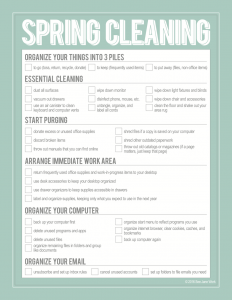Revitalize Your Work Space with Office Spring-Cleaning
 Now that spring has arrived, the internet—Pinterest especially—is abuzz with spring cleaning tips. Just like new year’s resolutions, spring cleaning is a ritual of fresh starts and renewal. While spring cleaning is typically associated with your home, the benefits of spring cleaning can—and should be—extended to your work space.
Now that spring has arrived, the internet—Pinterest especially—is abuzz with spring cleaning tips. Just like new year’s resolutions, spring cleaning is a ritual of fresh starts and renewal. While spring cleaning is typically associated with your home, the benefits of spring cleaning can—and should be—extended to your work space.
In the past, homeowners embraced spring cleaning to air the house out after being shut up and sooty all winter and to make the transition between running a house winter-style and summer-style. In today’s modern life, spring cleaning provides a way to tackle deep cleaning and organization tasks that don’t need to be done regularly, or ones that should be done regularly and you just…haven’t.
In this sense, spring cleaning is a perfect example of several of the strategies in author Gretchen Rubin’s nonfiction books on happiness, habit-forming, and organization. In particular, spring cleaning is a linking strategy. Rather than perpetually reminding yourself to do things like wiping off the accumulated dust on the back of your monitor, retrieving things that fell down the gap behind your bookcase, and hand-vacuuming the accumulated food crumbs from your pencil drawer, you can now let yourself forget about them. You’ll be tackling all of those kinds of tasks automatically, with the annual prompt of spring cleaning season.
Office Spring-Cleaning Checklist
I’m not the first to write about spring cleaning for the office. When I looked around online to see if there were aspects that hadn’t been covered yet, I came across a beautiful and comprehensive office spring cleaning checklist from 2016 on the blog at See Jane Work. Therefore, instead of reinventing the wheel, I’m going to point you directly to the blog post so you can download the checklist and print out a copy for yourself.
Notice, most of the things on this list are things you need to do yourself, even if you have an office cleaning service. Now, to help you complete the See Jane Work checklist, here are a few quick notes on some of the cleaning tasks.
Wipe Down Monitor
Glass cleaner and a paper towel? Non-scratching cloths? According to a CNET writer who untangled the contradictory advice on the subject, a dry, lint-free cloth is the way to go, followed by a weak solution with dish soap for tougher jobs. Details here.
Untangle Cords
There are lots of products out there to help you with cord control. But even if you don’t buy any tools, the point is to keep the surface of your desk uncluttered. Most desks have a tidy little hole at the back but cords always seem to find their way out of it. Spring cleaning is the time to put the cords back down it, and to purge your overfilled power strip of no-longer-needed chargers.
With intra-device cords (ones that are not so easily hidden down your desk’s cord-hole), try wrapping the excess length around the legs of a laptop riser or the base of your monitor.
Label Cords
The labeling of cords is most important for the cords you don’t use on a daily basis, are shared between co-workers, or used at different locations. There are lots of hacks out there for labeling cords (and products you can buy), but my personal favorite is to simply cut a blank address label in half lengthwise, write the product name on it, fold it around the cord, and seal the sticky ends.
Start Purging
In Marie Kondo’s blockbuster organization book, The Life-changing Magic of Tidying Up, one of her slogans was, “Discard everything that does not spark joy.” That is a dangerous proposition when used in an office setting, but so long as you don’t apply that to office property or against official recordkeeping requirements, it’s still a good thing to have on your mind as you tidy your desk or office.
Now is the time to consolidate to-do lists, throw away dried markers, comb through the break room fridge with your co-workers, and decide which of the four staplers in your desk will stay and which you will return to the common area.
 Organize Your Email
Organize Your Email
I’m always surprised by how many people tell me things like, “I had 250 emails today in my inbox today!” It’s not the number of emails that’s surprising; it’s the fact that these people are high-level professionals who have never taken the time to set up their professional email account so that it is organized and automated.
Each type of email has its own instructions for setting up rules and filters, but this article covers the subject in general terms and has several more email best practices. Here is a five-folder strategy from a writer at Fast Company if you want to get radical with your email.







